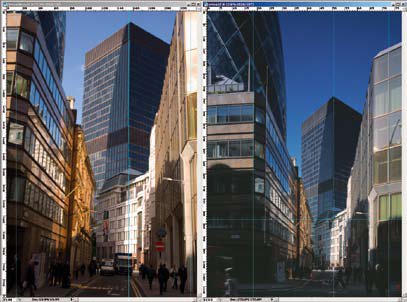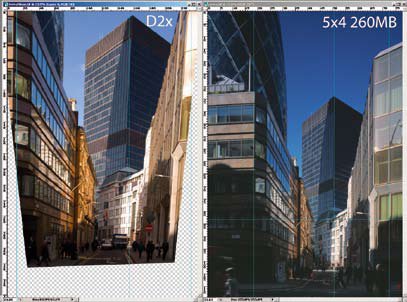articles/Digital/slr45-page4
Digital SLR v 5x4 - part 4 of 1 2 3 4
by Mike McNamee Published 01/09/2005

Round - 7 The Lens Drawing
There is a significant difference in both the subject field coverage and the distortion between the technologies. In both images, the building on the left of the view is leaning in (converging). For the 5x4, for which a rising front adjustment was made, the angle is merely 0.8°. The D2x had to be tilted up quite a bit to get the scene covered and the convergence is 6.3°. The Nikon has a smaller field of view in both horizontal and vertical planes. However, the D2x has one cunning feint up its sleeve, Photoshop CS2.
This has a new Lens Correction filter, specifically designed for correcting all forms of lens distortion. As the screen grab shows, there is some loss of pixels when correcting the verticals. In addition, a "Distort" transformation was also required to true up the image. Both of these procedures are heavy on pixel decimation. In the composite screen grab the corbels are once again compared and there is now more sharpness and detail in the 5x4 268MB file

Round - 8 The Colour Rendition
Shooting to 5x4 film puts an additional gamut and colour transform into the equation. The digital image is recorded directly to the chip and then (in this case) directly to the RAW file handler. This gives greater flexibility in determining the colour fidelity, and in all other tests we have done, digital out-performs film. The richer blue sky in the as-scanned shot from the 5x4 transparency may be preferred but such a rendering could easily have been achieved from the RAW file handler. For the images in question, there is a wider dynamic range in the D2x version, demonstrated by the broader histogram. There is also more contrast and more detail in the shadow area of the foreground.
For the film there is a suggestion that the fluorescent lighting in one of the offices is rendered more cleanly. There is a richer glow in the left-side masonry work from the D2x which may or may not be an accurate reflection of the scene. Similarly the façade of the building on the right is rendered more blue off the film that the digital version. After a bit of humming and haring the judges scored this round a draw.
The MC announces the Judges' Verdict The fight is drawn! The plucky newcomer has done enough to give the old-stager a run for his money.
The Monday Papers
We started out this contest expecting to have the digital knocked out cold in the first round and making polite remarks about how well it had done. Nothing could be further from the truth! We had to resort to more and more ingenious ways of looking at the files to discern differences. If you need to make perspective corrections the rising front of the field camera makes life an awful lot easier.
However, for a straight scene with a normal amount of detail, the D2x competes at least equally, sometimes better - we may even be talking about variations in the rear film plane accuracy of quick load film swaying the result. The D2x fans are demanding a rematch in any case, with a prime Nikkor at f5.6! One thing is sure, if you are getting grief from a features editor about accepting digital, push this article under his or her nose!
The Referee's Comment
Referee McMullin has declared the contest void and demanded a rematch, with more modern lenses on both cameras and primes on the D2x. More anon!
Please Note:
There is more than one page for this Article.
You are currently on page 4 Contact Mike McNamee
1st Published 01/09/2005
last update 09/12/2022 14:59:01
More Digital Articles
There are 0 days to get ready for The Society of Photographers Convention and Trade Show at The Novotel London West, Hammersmith ...
which starts on Wednesday 15th January 2025





